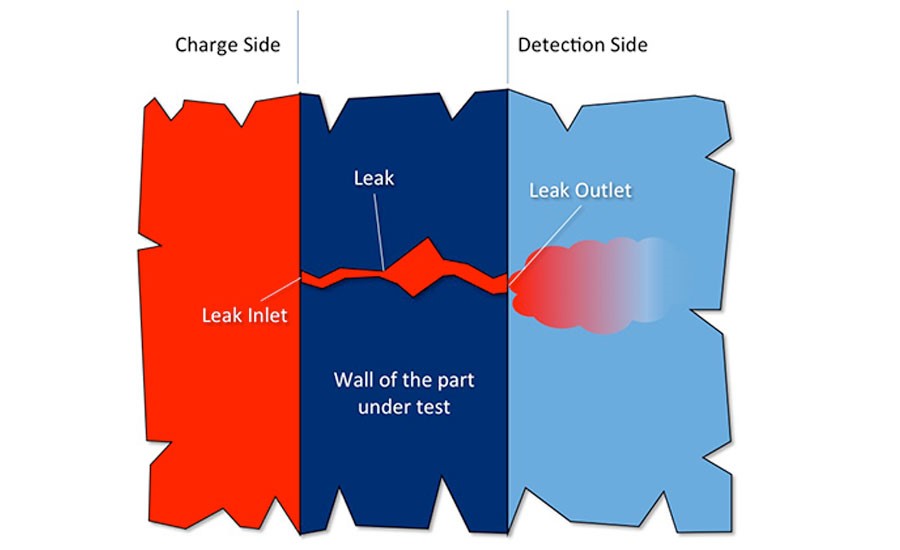Ensuring Accuracy with Helium Leak Testing: The Noise in the Background
Helium leak testing: from airbags to air-conditioning units and fuel rails, from anything implanted in the body to hermetically sealed enclosures for integrated circuits, there are some instances where the acceptable leak rate is so small it’s practically zero. Since air leak test methods such as pressure decay don’t have the necessary detection range to measure such small leaks, these situations call for a trace gas-based test method.
 The charge side is pressurized with a trace gas while the concentration of the same gas will be measured on the detection side. In many cases, the charge side is the inside of a part, but there are some cases, especially when checking hermeticity, when the outside of the part is charged. On the charge side, it is extremely important to ensure the highest possible concentration of trace gas at the inlet of the leak as the gas exiting the leak will have the same trace gas content. If the concentration is not high enough, the leak will have a very poor chance of being detected because the gas analyzer will only detect a concentration of leaking trace gas. In direct contrast with the charge side, the detection side should have as low a concentration of trace gas as possible before the test begins. Why? Because leak detectors can’t differentiate between the trace gas exiting a leak and the concentration of the trace gas that is already present in the atmosphere.
The charge side is pressurized with a trace gas while the concentration of the same gas will be measured on the detection side. In many cases, the charge side is the inside of a part, but there are some cases, especially when checking hermeticity, when the outside of the part is charged. On the charge side, it is extremely important to ensure the highest possible concentration of trace gas at the inlet of the leak as the gas exiting the leak will have the same trace gas content. If the concentration is not high enough, the leak will have a very poor chance of being detected because the gas analyzer will only detect a concentration of leaking trace gas. In direct contrast with the charge side, the detection side should have as low a concentration of trace gas as possible before the test begins. Why? Because leak detectors can’t differentiate between the trace gas exiting a leak and the concentration of the trace gas that is already present in the atmosphere.
Why Should I Use Trace Gas-Based Leak Testing?
Most air leak test methods measure leaks indirectly, through the change in a physical quantity (e.g. pressure change caused by a leak). The most sensitive detection range possible with this approach is approximately 1x10-3std.cm3/sec for very small parts. Trace gas methods, on the other hand, measure leaks directly. This allows for a much more sensitive detection range as little as 1x10-9std.cm3/sec – roughly 1 millionth of the low limit of an air leak test. Let’s have a closer look at a leak exposed to trace gas: The charge side is pressurized with a trace gas while the concentration of the same gas will be measured on the detection side. In many cases, the charge side is the inside of a part, but there are some cases, especially when checking hermeticity, when the outside of the part is charged. On the charge side, it is extremely important to ensure the highest possible concentration of trace gas at the inlet of the leak as the gas exiting the leak will have the same trace gas content. If the concentration is not high enough, the leak will have a very poor chance of being detected because the gas analyzer will only detect a concentration of leaking trace gas. In direct contrast with the charge side, the detection side should have as low a concentration of trace gas as possible before the test begins. Why? Because leak detectors can’t differentiate between the trace gas exiting a leak and the concentration of the trace gas that is already present in the atmosphere.
The charge side is pressurized with a trace gas while the concentration of the same gas will be measured on the detection side. In many cases, the charge side is the inside of a part, but there are some cases, especially when checking hermeticity, when the outside of the part is charged. On the charge side, it is extremely important to ensure the highest possible concentration of trace gas at the inlet of the leak as the gas exiting the leak will have the same trace gas content. If the concentration is not high enough, the leak will have a very poor chance of being detected because the gas analyzer will only detect a concentration of leaking trace gas. In direct contrast with the charge side, the detection side should have as low a concentration of trace gas as possible before the test begins. Why? Because leak detectors can’t differentiate between the trace gas exiting a leak and the concentration of the trace gas that is already present in the atmosphere.

